¶ Introduction
Ground traffic movements could be defined as a registered movement that takes place at the aerodrome surface, those movements generally include all taxiways, inactive runways, holding areas, and some transitional aprons or intersections where aircraft arrive, after vacating the runway or leaving the departure gate.
The ground controller will be the responsible for all those "movements" areas.
The ground controller has an important role at the airport operation. His position will guarantee a proper sequencing of departures, affecting the ground efficiency and safety of the aerodrome.
¶ Basic definitions
¶ Runway
A runway is a defined rectangular surface on an airport, suitable for the landings or take offs of aircraft.

¶ Taxiway
Taxiways are defined paths established for the taxiing of aircraft from one part of the airport to another.
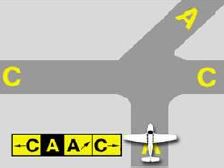
¶ Movement Areas
Movement areas are defined as the runways, taxiways, and other areas of an airport which are used for taxiing, air taxiing, takeoff, and landing, exclusive of loading ramps and aircraft parking areas.
¶ Apron/Park area
Apron or Park areas are defined surfaces dedicated to park the aircraft for short or long time and dedicated areas to embark or disembark passengers or cargo loads.
¶ Basic Requirements
The ground controller needs to be familiarized with his airfield, and to fulfil several requirements:
- Adequate and up-to-date Sector File in IVAO ATC software (contact your local division or consult the web site).
- Ground movement charts of the aerodrome (taxi layouts, runways, taxiways, aprons, others).
The ground controller shall be familiar with ground phraseology.
Any active or non-closed runways are not part of the ground traffic management.
¶ Push-back management
Once the pilot has completed the operational procedures of the aircraft, he will be ready to start the flight (after receiving initial clearance for IFR Flight). The first pilot's task is to complete the "Push-Back and Start-Up Procedure".
Depending on aircraft position on the apron or park area, this push-back procedure cannot be necessary. IFR aircraft are usually performing their engine start-up procedure during push back.
The "Push-Back and Start-Up Clearance" should be issued taking into consideration that some factors have been reviewed; those factors are:
- Meteorological conditions (Ice, Sand, Slush).
- Runway for departure (Active Runway).
- Taxiway route from the ramp to the active runway.
- Noise abatement procedure.
- Nearby aircraft, equipment and ramp workers.
The ground controller shall approve a push back. The use of 'cleared' term is forbidden for push back.
The main goal of the ground controller is to provide the most secure operation between the involved aircraft at the ramp; great emphasis is given to prevent ground collisions; it is really important to give clear and concise information in order to avoid mislead and confusion between the controller and the flight crew.
When a ground controller is giving the push back instruction to a pilot, he cannot know how much time the push back operation will take.
¶ Push-back phraseology
To help the ground controller to manage the ground, push back can be handled like the following examples:
Push back instruction can be issued with using cardinal reference in order to help the pilot to have reference:
- 📡IBERIA 251, PUSH BACK APPROVED FACING EAST.
Push-Back Instruction using another aircraft as reference:
- 📡IBERIA 251, PUSH BACK APPROVED FACING EAST, CAUTION WITH THE HEAVY 747 AT YOUR 4 O'CLOCK COMPLETING THE PUSHBACK MANOEUVRE, REPORT THE AIRCRAFT IN SIGHT
Push-Back Instruction using the runway as reference:
- 📡IBERIA 251, PUSH BACK APPROVED FACING EAST INTO THE RUNWAY 35/17.
Push-Back Instruction using the taxiway or lines as reference:
- 📡IBERIA 251, PUSH BACK APPROVED FACING EAST TO THE TAXIWAY GOLF LINE ORANGE.
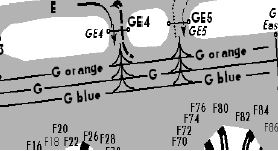
¶ Multi push-back clearances
A push back clearance is very easy to handle by the ground controller if there are only very few aircraft on the ground. But the push back management can be harder when:
- Many aircraft are on the ground taxiing and pushing back at the same time.
- Close aircraft on the ground pushing back
- Little apron without much place with more than one aircraft.
An aircraft can block a taxiway or an apron with a long time push back. This must be taken into account for traffic management on the ground.
Multiple push back clearances could be issued once the factors have been reviewed and the involved aircraft have a visual reference between them. At the same time, the flight crew will guarantee a proper communication with the ground controller and ramp crew. In the example below, one medium aircraft is pushing back (green arrow) behind the 2 heavy aircraft.
In this situation, as ground controller, you must not give any push-back instruction to the 2 heavy aircraft due to possible collision!
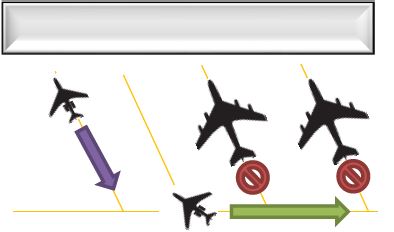
In this situation, you can give a push back clearance for the other medium aircraft (violet arrow), but if you do that:
- If there is only one taxiway, the second push back clearance implies that the first aircraft (green arrow) cannot taxi and must wait for the other medium traffic to taxi.
- You cannot free the space behind the 2 heavy aircraft before the 2 medium aircraft have vacated the taxiway.
This example shows the job of the ground controller: select the correct push back instruction to the adequate aircraft in function of the other aircraft. You must think about the status of these aircraft and answer typical questions like:
- Has this aircraft contacted me?
- Has this aircraft his initial IFR clearance?
- Has this aircraft asked his push-back?
The ground controller will have different options and variables to ensure the proper handling of all the aircraft involved in the ground movement manoeuvre:
- Use different taxiways or lines for push back.
- Use different cardinal directions for push back.
- Delay push-back due to another push-back.
- Use another aircraft taxiing as a reference to start a push-back.
Aircraft cannot see any traffic behind them. They can only see the traffic on their right, left or in front of them!
¶ Holding point selection and management
The tower will have the responsibility over the active runways, once the proper coordination has been established, the ground controller will decide and provide the most suitable taxi route for the aircraft.
The active runway could have several holding intersections that could be used for departure. It is important to know that some aircraft have limited weight operations that could affect the takeoff procedure due to the runway length. Some guidelines for the selection of a suitable holding point for each traffic are presented below.
¶ The use of the maximum rwy distance available
For safety reasons, the pilot shall perform his take-off using the maximum runway available distance. But in some cases, a pilot can ask another holding point with less runway available distance. The pilot can want that holding point for:
- Reducing the taxiway distance before take-off to avoid ground taxi consumption.
- Reducing the taxiway distance before take-off to gain time.
When a pilot asks an intermediate holding point, he must be sure that the runway available distance is suitable for his taking-off, taking into account the margin of error of taking-off distance calculation and weather effects.
Also a controller can propose an intermediate holding point to a pilot, but he must know the taking-off runway distance available from this holding point and inform the pilot in command. The pilot can accept or refuse this intermediate holding point.
Except for safety reasons, a controller cannot impose an intermediate holding point to a pilot.
¶ VFR and IFR management
In a commuter airfield, you can have different types of aircraft:
- Light or medium (or heavy)
- Commercial IFR flight, IFR general aviation, VFR
- Helicopter, military aircraft
With these different types of aircraft, it is sometime difficult to manage the ground with one unique holding point.
Light aircraft or VFR aircraft are usually using less runway length for taking-off, and it can be a possibility to use intermediate holding points to manage VFR or light aircrafts in order to not mix all types of traffic at the same holding point.

These cosiderations depend on the national regulations and the AIP.
¶ Holding point selection in large international airports
In large international airports, tower controllers can manage their departure sequence in function of the aircraft wake turbulence category (light, medium, heavy or super heavy).
As the departure separation time is increased for a medium aircraft behind a heavy aircraft, a tower controller can loose much waiting time with handling randomly ordered sequence of aircraft at the same holding point.
In larger airports, with dual parallel taxiways, the ground controller can create two sequences:
- One with only the heavy aircraft for the latest holding point with the full taking-off runway distance available.
- Another with the medium aircraft for preceding holding point with less landing runway distance available.
With that, the tower controller can make its own regulation with using both line and holding points to manage his departure sequence.
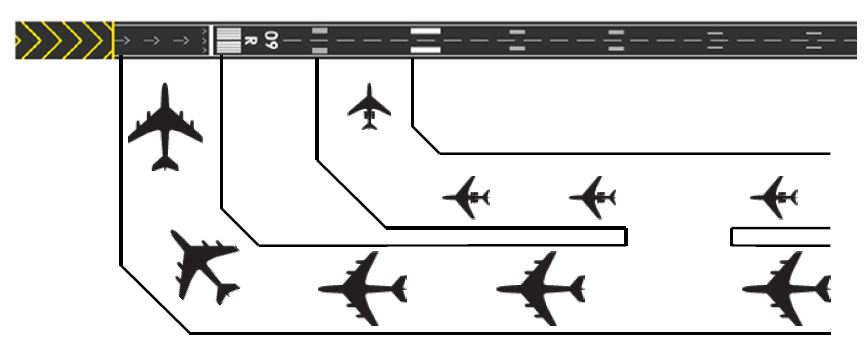
The ground controller should be familiar with the wake turbulence category of the aircraft which he or she will be handling. The ground controller will use the reference filed at the Item 9 of the ICAO model flight plan form (L, M, H). This information will be based on the maximum certificated take-off mass.
¶ Taxi instructions & ground management
Once the aircraft has completed the push back and start up, the flight crew will call requesting taxi instructions to the active runway.
The taxi clearance should be issued and this can include concise and necessary information to assist the flight crew to follow the correct taxi route. Using this way, they shall avoid collision with other aircraft or objects and minimize the runway incursion risk.
¶ Taxi phraseology
The basic taxi clearance must include the runway number:
- 📡FRANCE 211, TAXI TO HOLDING POINT RUNWAY 10
In complex airports, the ground controller can give sequential taxiways:
- 📡FRANCE 211, TAXI TO HOLDING POINT RUNWAY 10, VIA CHARLIE AND ALPHA
Pay attention, that it is not necessary and not operational to give all the sequential taxiways. A number of 3 taxiways is the maximum recommended in the taxi clearance to minimize the read-back mistakes and pilot mistakes.
¶ Ground management through the taxi operation
The ground controller should have visual contact with the ground radar all the time; aircraft could get really close between them at several intersections and taxiways.
It is mandatory to give traffic information on ground in order to prevent collisions. Traffic information can be given in a taxi clearance.
Taxi clearance with traffic information:
- 📡IBERIA 251**,** TAXI TO HOLDING POINT RUNWAY 10, VIA CHARLIE AND ALPHA, CAUTION WITH THE BOEING 747 OF AIR FRANCE, TAXIING VIA C FROM RIGHT TO LEFT
Taxi clearance with traffic information given with additional traffic following clearance:
- 📡AIR EUROPA 451 TAXI TO HOLDING RUNWAY 10, VIA ALPHA, FOLLOW THE BOEING 747 OF AIR FRANCE AT YOUR 3 O'CLOCK TAXIING VIA CHARLIE
¶ Arrival management
Once the aircraft has completed the landing manoeuvre and has vacated the runway, it will call the ground controller in order to ensure the taxi route to the airport apron.
The ground controller has the responsibility to determine the aircraft position and give the proper instructions to expedite the traffic flow and free all the exit points that are close to the runway in the shortest possible time:
- 📡IBERIA 251, TAXI TO THE INTERNATIONAL RAMP, GATE 28, VIA CHARLIE
- 📡IBERIA 251, TAXI TO THE NATIONAL RAMP GATE 1, VIA FOXTROT AND GOLF. CAUTION WITH THE BOEING 747 OF AIR FRANCE TAXIING VIA FOXTROT TO THE INTERNATIONAL RAMP
- 📡IBERIA 251, TAXI TO THE INTERNATIONAL RAMP, GATE 28. FOLLOW THE AIRBUS A340 OF LUFTHANSA, TAXIING VIA FOXTROT TO THE GATE 27
¶ Runway crossing
Sometimes, arriving traffic and departing traffic can create a conflict by using the same taxiway at the same time. The ground controller can stop taxiing departing traffic in order to leave a taxiway free for arriving aircraft.
- 📡IBERIA 251, TAXI TO THE INTERNATIONAL RAMP GATE 16, VIA FOXTROT AND CHARLIE. CAUTION WITH THE BOEING 747 OF AIR FRANCE, TAXIING VIA ECHO TO THE HOLDING POINT RUNWAY 10
- 📡AIR FRANCE 225, CROSS RUNWAY 09 AND STOP AT ECHO. CAUTION WITH THE AIRBUS 340 OF IBERIA, TAXIING AT ECHO AND FOXTROT
- 📡AIR FRANCE 225, TAXI HOLDING POINT RUNWAY 10, VIA FOXTROT AND ALPHA, FOLLOW AIRBUS 340 OF IBERIA
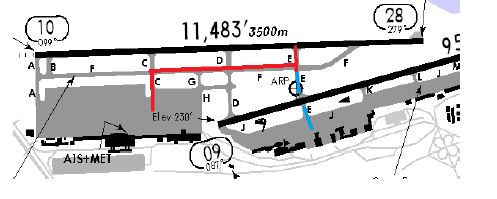
¶ Special taxiing operation
¶ Taxiing using a runway
Aircraft may be permitted to taxi via a runway in use.
The reasons to use a runway as a taxiway can be:
- The apron has only one exit via a runway in order to join another apron or runway
- Large aircraft cannot take small taxiways and must taxi via a runway
- The apron is full of aircraft and one aircraft cannot use another taxiway
- An aircraft is lost on the ground and takes a wrong taxiway
- Backtracking operation
These instructions shall be given by the tower controller, who is responsible for all runway operations. Except after a pre-decided coordination between the tower and the ground controllers, the pilot shall be transferred to the tower controller on his frequency by the ground controller before using a taxi clearance via a runway.
In the example below, imagine that the apron JULIET is full of aircraft and one aircraft shall take holding point KILO in order to reach holding point runway 10 (runway 09 is too short for take-off):
- 📡IBERIA 251, MAINTAIN HOLDING POINT RUNWAY 09 AND CONTACT TOWER ON 118.1. TOWER, AT HOLDING POINT KILO RUNWAY 09
- 📡IBERIA 251, TAXI VIA RUNWAY 09, TAKE FIRST EXIT ON YOUR RIGHT VIA ECHO, REPORT RUNWAY VACATED
- 📡IBERIA 251 CONTACT GROUND ON 124.825
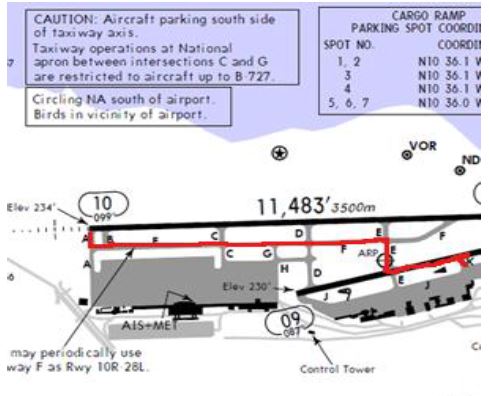
¶ Crossing a non-closed runway
Taxi clearances sometimes have a taxi limit beyond a runway; it is necessary to determine if that clearance shall include a clearance to cross the runway or an instruction to hold before that runway.
Pay attention that taxiing aircraft control is provided by a ground controller and the control of the active runway by an aerodrome or tower controller (TWR), the latter shall approve this action.
If runway 09 is a closed runway, the ground controller can handle the crossing operation:
- 📡IBERIA 251, TAXI HOLDING POINT RUNWAY 09 VIA ECHO, CROSS RUNWAY 09, THEN TAXI HOLDING POINT RUNWAY 10 VIA ALPHA AND FOXTROT.\
If runway 09 is an active runway and runway 09 is not suitable for aircraft departure, the ground controller must transfer the aircraft to the tower controller frequency before crossing this active runway:
- 📡IBERIA 251, MAINTAIN HOLDING POINT RUNWAY 09 AND CONTACT TOWER ON 118.1.
- 📡IBERIA 251, CROSS RUNWAY 09, REPORT RUNWAY VACATED.
- 📡IBERIA 251 CONTACT GROUND ON 124.825.
In some countries, depending on the national regulations applicable to the airfield or with pre-coordination between aerodrome and tower controller, an active runway crossing can be managed by the ground controller under the tower controller's responsibility.
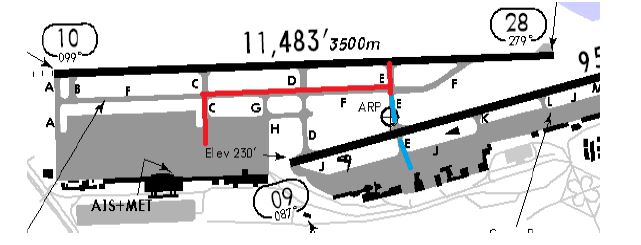
¶ Helicopter taxiing operations
Some provisions shall be taken in order to ensure the safe operation of helicopters when taxiing over the surface. The controller needs to know that a proper separation must exist between the air-taxiing helicopter and the surrounding aircraft or helicopters to avoid the effects of wake turbulence.
A helicopter is usually taxiing by flying at a very low altitude below 100 or 200 feet, just over the taxiways, aprons or runways:
- 📡N9TT, AIR TAXI VIA JULIETT, TO THE HELIPAD, AVOID GENERAL AVIATION AIRCRAFT AT YOUR 12 O’CLOCK, REMAIN AT OR BELOW 200 FEET
¶ Transfer and handoffs
A fluent coordination shall be executed in order to guarantee the safety of the operation.
- The transfer point of departing aircraft to the air traffic controller responsible of the tower control is when the aircraft approaches the holding point.
- The transfer point of arriving aircraft from the air traffic controller responsible of the tower control is after the aircraft has vacated the runway.
Pay attention that a controller shall not await the traffic stop before the hand off operation to the next controller.
- none
- ICAO Documentation 4444 - Air Traffic Management - 16th Edition 2016 - Chapter 7.6
- VID 150259 - Creation
- VID 435695 - Wiki integration
- VID 496402 - Wiki.js integration